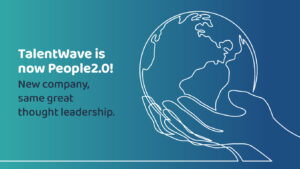EDITORS NOTE: This is the first in a 2 part series on critical workforce trends for today’s HR leaders:
- In part 1 – we’ll take a look at some of the macro workforce and workplace trends that have created an unprecedented challenging environment for HR practitioners.
- In part 2 – we’ll present a few forward-thinking ideas and progressive strategies that we’ve learned from TalentWave clients to help your organization build and manage the flexible workforce you need to succeed.
Introduction
With the rapid evolution of the workplace and a seismic shift in the workforce, Human Resources leaders are being challenged like never before. In order to stay ahead of a number of dramatic changes impacting the future of business, these leaders must develop strategies that enable their organizations to attract and retain the talent they need in order to get vital work done.
As HR professionals start to think about their strategic roadmaps and focus their teams heading into 2016 here are some of the critical trends we see shaping the future of work:
1 – The Growing Shortage of Skilled Workers: It is estimated that by 2020 in the US the number of college educated workers will decline by 30-40 million and there will be a surplus of “low-skilled,” non-college educated workers. Today, most college grads are coming out of a 4, 5, or 6 year university experience and, eventually, stepping into traditional middle class roles: office managers, executive assistants, financial planners, business analysts, etc. These roles typically require the ability to combine strong people skills with a few technical skills need to perform a specific job.
It is expected that there will be a large increase in demand for highly specialized skilled roles such as software developers, petroleum engineers, and nurses. The hard truth is that we are simply not producing enough STEM (Science, Technology, Engineering, Math) college graduates to fill these roles. On the “low-skilled” spectrum, there is a projected 39% increase in demand for roles like: home healthcare specialists, fast-food servers and landscape workers. Those in the middle will become relatively less in demand and the ability to find workers that have a specific set of skills will become increasingly difficult.
How do we prepare our current students entering the workforce and this new workplace? The consensus among workforce experts is that we need to improve collaboration between the educational system, the private sector and government to better communicate to students at an earlier age (think high school instead of college), the skills required in order to be successful in the workforce.
2 – The Exit of the Boomers and the Rise of the Millennials: The Baby Boomers (born between 1946 and 1964) are the largest and most well-educated generation in US history. This massive segment of the workforce is now beginning to retire in a big way – It has been estimated that in the US a Baby Boomer retires every 17 seconds! Stepping into this void are the younger workers in Generation X and the Millennials. The Millennial generation is the same size as the Boomers, and by the year 2020, Millennials will make up 46% of the workforce. In 2025, they will dominate the workforce with a whopping 75%!
Since technology, instant availability of information, and collaboration is so important to Millennials, smart employers will start adapting their traditional business models to accommodate this incoming tech-savvy, team-oriented workforce. Being open-minded to new methods of communication including video conferencing tools and the ability to share instant updates using various instant messengers services, will help employers attract and retain these valuable workers.
3 – Work/Life Balance: While the leading edge of Baby Boomers are retiring, many are still wanting (or in many cases, needing) income and some level of a professional role. They just don’t want a traditional full-time job. In addition, as an off-shoot of more Millennials in the workforce and more flexible workers overall, we’ll see a growth in workers demanding greater work/life balance. As a result, more workers will demand flexible or event virtual employee positions.
With the rapid advances in technology, new tools and systems have been developed to aid employees in being better connected, more collaborative and highly productive from virtually anywhere in the world, so long as they have a internet access. Smart organizations are developing programs that cater to worker’s demands for better work/life balance and flexibility. The flexible and remote work trend is real, and leading companies are leveraging it to attract and retain their Millennial talent and provide greater flexibility to Gen X and Baby Boomer employees.
4 – Growth of the Flexible Workforce: Two-thirds of the new jobs added in the past year were staffed with contingent workers. The flexible workforce makes up about 20% of the workforce population today, and many workforce experts project that this number will increase to 40-50% in the next 10 years.
It is no secret that contingent work is ideal for individuals with nontraditional families (Definition: both parents working or 1 parent households. Which, by the way, constitute 83% of all US households according to the US Census Bureau!), students who are continuing their education but understand that they need real world work experience before they can land their dream job, or even people that want to be able to travel for extensive periods of time and work on project-based work in between adventures. Contingent workers also provide flexibility, access to critical skills, and can also provide some financial relief to employers who want to bring on SME’s to help them during periods of high growth, but can’t justify the full-time employee expenses for a traditional FTE role.
As a result, more workers than ever are choosing to be independent solo-preneurs. Fast Company magazine estimates that by 2020, “about half of non-governmental workers in the U.S. will be contract workers – not permanent, full-time employees.” Ardent Partners predicts that by the end of 2017, nearly 45% of the world’s total workforce will be comprised of contingent workers, including IC’s, SOW-based workers, and freelancers. While the US Bureau of Labor Statistics puts it at 40%, which is a dramatic increase from their estimate of 24% in 2001.
Regardless of which prediction is right, it is clear that the flexible workforce is here to stay, will continue to grow, and cannot be ignored by today’s HR leaders.
5 – Globalization of the Labor Market: Globalization of the workforce has become a political hot button. We’ve all heard the horror stories of American workers losing their jobs to outsourced work/labor to foreign markets. While some critics see this business move as categorically un-American, others see it as strategic and fiscally responsible. While some companies that have moved their engineering and development work to teams oversees have reported that they received better value for their money and the finished product was of higher quality. Others have reported that the hassles of remote workers, time-zone and language barriers have not yielded the results they expected.
So long as customer service and performance standards are met, it may still make sense for some of these low-skill transactional jobs to be moved to lower-cost countries. To that end, it is projected that over the next 5 years, nearly 2 million financial services jobs will move from the US and by 2030, 3 million service sector jobs will be moved overseas.
In the second half of this article, we’ll examine a few forward-thinking ideas and progressive strategies we’ve learned from TalentWave clients that will help your organization build and manage the flexible workforce you need to succeed.



